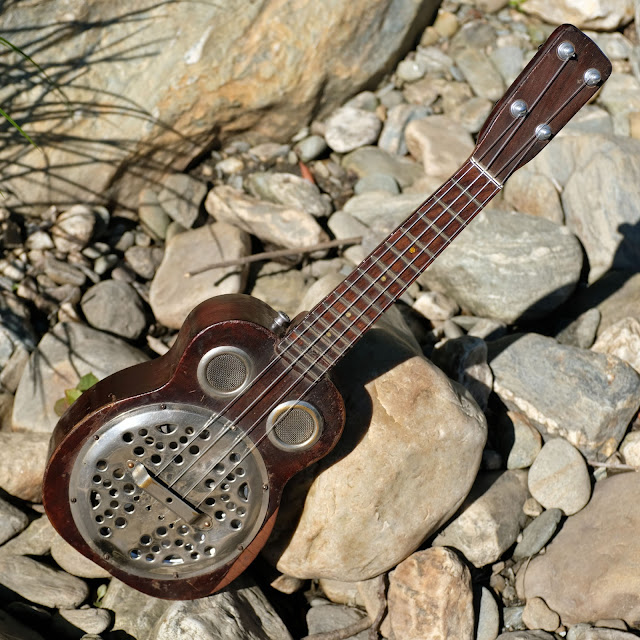1930s Regal-made Dobro Spider-Bridge Resonator Ukulele
Update July 2018: Since originally posting this, I replaced the original damaged Dobro cone with a new National resonator cone (flipped upside-down to suit the spider bridge setup) and it transformed this thing into a jazzy-sounding powerhouse of a uke. I've put a new video link in and taken fresh photos. Now back to the original description (albeit slightly-updated)...
I adjusted one of this same-model uke years ago and have been curious about properly sprucing one up for a long time, now. I spotted this on eBay where it was listed as a "resinator guitar" with very, very dubious photos and clear evidence of some heavy-handed destructor having been at it. Still, I needed it. They're not exactly growing on trees and they pop up only once in a while.
I adjusted one of this same-model uke years ago and have been curious about properly sprucing one up for a long time, now. I spotted this on eBay where it was listed as a "resinator guitar" with very, very dubious photos and clear evidence of some heavy-handed destructor having been at it. Still, I needed it. They're not exactly growing on trees and they pop up only once in a while.
This particular model of resonator uke features a spider-bridge (Dobro-style cone) design with two "screen" soundholes. It has a full soundwell under the hood and is built from ply mahogany throughout, though the neck is solid mahogany and has a rosewood fretboard. Regal made the bodies and necks for these Dobro instruments (though this one is unbranded), and their hand is in the design right from the sculpt of the headstock edging. Overall the body is a little bigger than your average soprano, too. This one is marked "Factory Second" at the headstock and that may be the reason there's no branding at all on it.
When it came in, it was just as bad as I expected. Check out the workshop blog post for that. I wasn't deterred, though. After many hours of work, I got it all shored-up with a new, inverted (for use with the spider birdge) National cone installed and it sounds tremendous. Tone is full, thick, and almost jazzy-mellow with a good amount of bass (for a uke) and heavy mids-presence. It's got a lot of volume and cut, too. I'm well-pleased! Compared to one of these with the original cone that I worked-on slightly-later, this one has a little less sparkle and a little more guts.
My work included fixing-up a damaged soundwell and installing a new National cone, installing new ebony saddles (and fixing a damaged area of the saddle-holder wall), hiding an old screw-fix repair job at the fretboard, giving it a fret level/dress, modifying the tailpiece/string retaining design to an on-the-plate design, regluing some delaminated ply here and there, lots of cleaning, installing a set of Gotoh UPT (~$72) 4:1 geared pegs at the headstock, and a proper setup.
Specs are: 13 7/8" scale, 1 5/16" nut width, 1 1/16" string spacing at the nut, 1 1/2" spacing at the bridge, 7 3/8" lower bout, 5 3/4" upper bout, and 2 1/2" depth. Action is spot-on at 1/16" at the 12th fret and I have it strung with heavy-gauge GCEA-tuning Worth fluorocarbon strings as resonator ukes tend to like extra tension.
The edging along the headstock looks nice... though the practical, new, ~$70 Gotoh 4:1 tuners are nicer.
The dot inlay is gold-sparkle celluloid. I added side dots and seated the frets properly during my level/dress job. They have plenty of height left and feel pretty good. Note that there's muck on the board at the 14th fret. There was a screw-end sticking out there from an old neck repair job and I countersunk a new one and hid it.
The screen soundholes are great. All the hardware is original, by the way, save the tuners, saddles, and cone.
So here's the thing -- the coverplate is not perfectly domed like it used to be. To deal with the neck angle and changes with the cone over time, I had to seat everything a hair lower and so I've wiggle-waggled the coverplate into submission with a slightly convex shape in the center. It works well and holds-pat, so I'm happy.
I also did away with the original tailpiece string load and drilled new holes-n-slots for string-mounting on the coverplate itself, like you'd see on a National (or similar) resonator uke. Don't worry -- I made sure to de-burr the holes so the strings won't get cut. It's a drastic design change, but affords good back-angle on the saddle -- which is what's needed to drive the cone in this design if one wants to use nylon/fluoro. I did try this out with steel, but did not like the tone.
FYI -- you can see a missing first layer of ply on the top, lower-bout, treble-side.
The "factory second" mark on the back of the headstock is hilarious. Note the filled holes from old tuner installs.
Here's the unsighly old neck repair work. It's strong and stable in service, however, so I won't complain too much. Note the related (and repaired) splits in the sides, too.
I added vintage-looking strap buttons so I could hang it by a cord for more mobility-while-playing.



















Comments